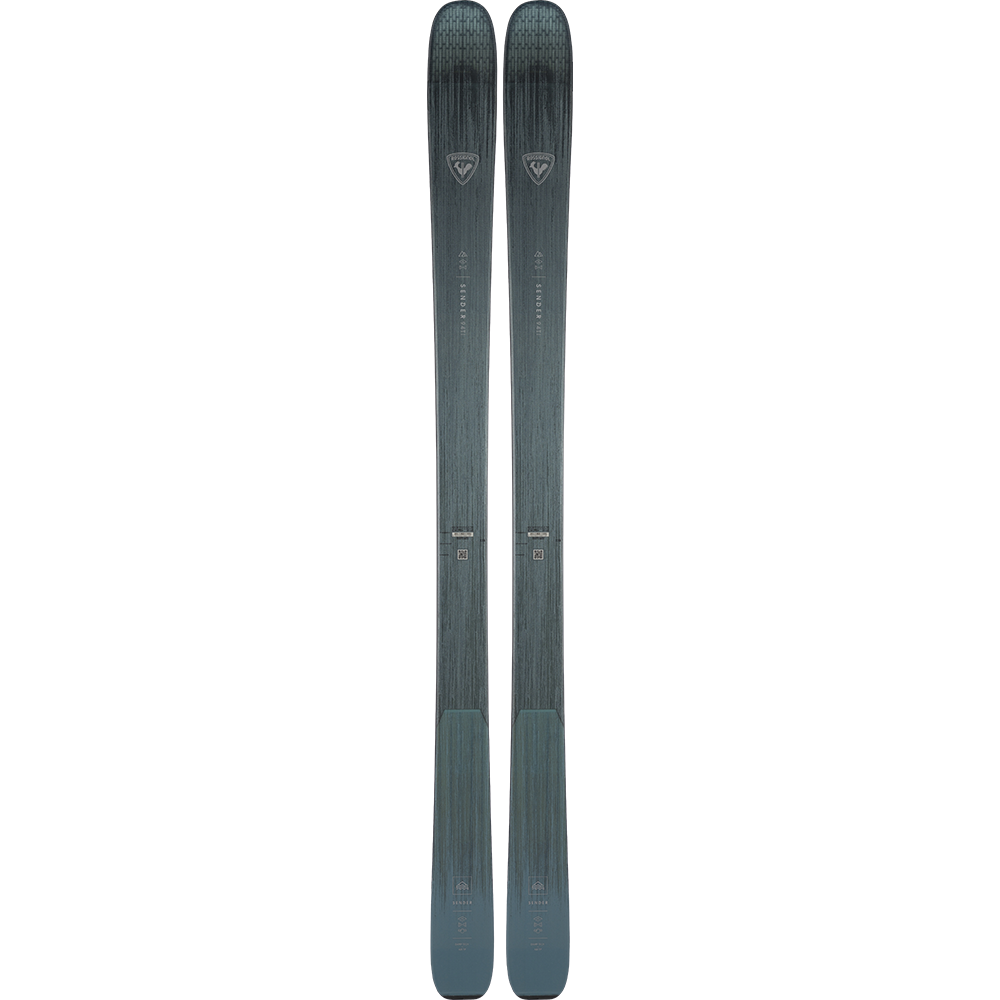Rossignol Sender 94 Ti
NEARLY A DECADE AGO, ROSSIGNOL RELEASED THE SOUL 7—an all-mountain ski that helped popularize the freeriding movement. The Sender line, the brand’s updated collection based on the Soul program was previously
offered in just two models—the 104 Ti and 106 Ti. But it grows by one this season with the introduction of the piste-focused Rossignol Sender 94 Ti.
Surveying the market, Rossignol knew it needed a mid-90s underfoot ski that did way more than just carve—something with the energy to be able to ski just about anything, anywhere.
“I ski Deer Valley regularly and my everyday ski used to be the 106 Ti. This past winter I skied the 94 Ti [more often]; it was just easier underfoot,” Rossignol Alpine Category Manager Jake Stevens said. “I could put it up on-edge easier, it was more playful and I could have an easier time in general. It rips, but if I want to dip into the trees or go steal a line in one of the bowls up high, it can do that too.”
The Rossignol Sender 94 Ti features a paulownia wood core for weight savings and their proprietary Damp Tech in the tip and the tail to ensure a smooth feeling that inspires confidence in variable conditions.
Rossignol re-examined its popular Air Tip technology in the 94 Ti by reducing the size by 50 percent and integrating the wood core further into the shovel, adding a more balanced, grounded feel underfoot. While Air Tip has always provided lightness and maneuverability, by integrating the wood core further up the ski, it enables a quicker connection to the snow that carries throughout the turn.
Born out of Rossignol’s race department, a Titanal beam underfoot allows for unique and versatile flex patterns. While tip-to-tail or edge-to- edge Titanal laminate can make a ski very strong and grippy, limiting the metal to underfoot provides more forgiveness.
“The Titanal beam allows the ski to flex in three different ways,” Stevens explained. “It has the normal camber flex, the normal twisting flex but it also allows the ski to flex underfoot. When you put it on-edge, rather than it just being completely solid and wanting to have pure grip, it allows the sidewall to move a little bit more.”
The outcome is a well-balanced ski that can arc with the best of them but is also playful and maneuverable through bumps and mini-golf style terrain. An expert can really push this ski, but can also enjoy the forgiveness it offers when your dogs start barking.
“When I’ve put friends on this ski, they’ve all had a blast—whether they’re a big-mountain/freeride pro athlete, a former racer or just a weekend warrior,” Stevens said. “With less powder these days, I think everyone can benefit from a narrower ski that’s easier on your knees, uses less energy and allows you to be a bit more playful.”
Explore the 2023 FREESKIER Buyer’s Guide

Hover image to zoom
NEARLY A DECADE AGO, ROSSIGNOL RELEASED THE SOUL 7—an all-mountain ski that helped popularize the freeriding movement. The Sender line, the brand’s updated collection based on the Soul program was previously
offered in just two models—the 104 Ti and 106 Ti. But it grows by one this season with the introduction of the piste-focused Rossignol Sender 94 Ti.
Surveying the market, Rossignol knew it needed a mid-90s underfoot ski that did way more than just carve—something with the energy to be able to ski just about anything, anywhere.
“I ski Deer Valley regularly and my everyday ski used to be the 106 Ti. This past winter I skied the 94 Ti [more often]; it was just easier underfoot,” Rossignol Alpine Category Manager Jake Stevens said. “I could put it up on-edge easier, it was more playful and I could have an easier time in general. It rips, but if I want to dip into the trees or go steal a line in one of the bowls up high, it can do that too.”
The Rossignol Sender 94 Ti features a paulownia wood core for weight savings and their proprietary Damp Tech in the tip and the tail to ensure a smooth feeling that inspires confidence in variable conditions.
Rossignol re-examined its popular Air Tip technology in the 94 Ti by reducing the size by 50 percent and integrating the wood core further into the shovel, adding a more balanced, grounded feel underfoot. While Air Tip has always provided lightness and maneuverability, by integrating the wood core further up the ski, it enables a quicker connection to the snow that carries throughout the turn.
Born out of Rossignol’s race department, a Titanal beam underfoot allows for unique and versatile flex patterns. While tip-to-tail or edge-to- edge Titanal laminate can make a ski very strong and grippy, limiting the metal to underfoot provides more forgiveness.
“The Titanal beam allows the ski to flex in three different ways,” Stevens explained. “It has the normal camber flex, the normal twisting flex but it also allows the ski to flex underfoot. When you put it on-edge, rather than it just being completely solid and wanting to have pure grip, it allows the sidewall to move a little bit more.”
The outcome is a well-balanced ski that can arc with the best of them but is also playful and maneuverable through bumps and mini-golf style terrain. An expert can really push this ski, but can also enjoy the forgiveness it offers when your dogs start barking.
“When I’ve put friends on this ski, they’ve all had a blast—whether they’re a big-mountain/freeride pro athlete, a former racer or just a weekend warrior,” Stevens said. “With less powder these days, I think everyone can benefit from a narrower ski that’s easier on your knees, uses less energy and allows you to be a bit more playful.”